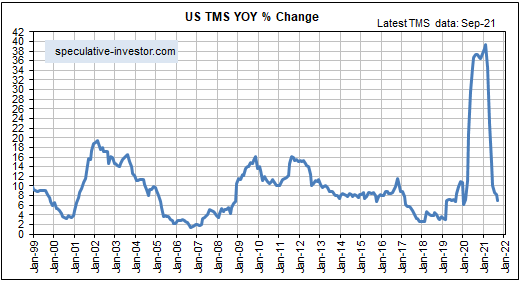[This blog post is an excerpt from a commentary posted at speculative-investor.com about two weeks ago]
The US financial system currently has an abundance of ‘liquidity’. We know that this is the case because US credit spreads are close to multi-decade lows. The probability of a liquidity crisis or crunch with credit spreads near their narrowest levels in decades is not just low, it is zero. However, the money-supply growth trend warns that a boom-to-bust transition could begin as soon as the first half of 2022, potentially setting the stage for a major financial-market event/crisis during the second half of 2022.
The US money-supply growth trend is illustrated by the following chart. The chart shows that the year-over-year rate of growth in US True Money Supply (TMS) peaked at almost 40% early this year and has since collapsed to around 7%.

We thought that the TMS growth rate would level out during September, but instead it extended its steep decline. The reason is that the Fed, via its Reverse Repo (RRP) program, removed $330B from the financial system over the course of the month. To put it another way, for every dollar the Fed added via its QE program during September it removed almost three dollars via its Reverse Repo program.
If not for the Fed’s additions to its RRP program in September, the TMS growth rate would have ended the month at 8.7% (slightly above the end-August level) instead of 7.0%. Furthermore, if not for all the money removed by the Fed via RRP’s since the program was initiated in March of this year, the TMS growth rate would now be 14.5% as opposed to 7.0%.
As an aside, the Fed hasn’t removed a lot of money ($1.43 trillion at the time of writing) from the US financial system over the past seven months in an effort to tighten monetary conditions; it has done so to address a problem that can be aptly described as a surplus of dollars. There has been a huge quantity of dollars ‘sloshing around’ the financial system looking for a zero-risk, temporary home with a small positive yield. The Fed’s RRP program has provided such a home.
All of the money removed by the Fed via RRP’s will be returned to the US financial system at some point (probably next year). However, the US TMS growth rate has fallen far enough to suggest that the next trend reversal in credit spreads from narrowing to widening will mark the start of a boom-to-bust transition rather than just an interruption to the boom.
By the same token, until the credit-spreads trend reversal happens it will be reasonable to assume that the boom is intact and that there won’t be anything more bearish than moderate corrections in the senior equity and commodity indices.
 Print This Post
Print This Post
